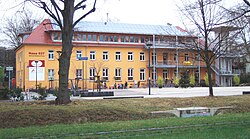Vauban barracks
|
|
|||
|---|---|---|---|

Former barracks building, |
|||
| country | Germany | ||
| today | residential area | ||
| local community | Freiburg in Breisgau | ||
| Coordinates : | 47 ° 58 ′ N , 7 ° 50 ′ E | ||
| Opened | 1937 | ||
| owner | Private | ||
| Old barracks names | |||
| 1937-1945 1945-1992 |
Schlageter barracks in the Vauban quarter |
|
|
| Formerly stationed units | |||
| 75th Infantry Regiment |
|
||
|
Location of the Vauban barracks in Baden-Württemberg |
|||
The Vauban barracks (French: Quartier Vauban ) in Freiburg im Breisgau in Baden-Württemberg was a location of the French armed forces in Germany (FFA) for the longest period of its military use .
Originally it was built in 1937 for the German Wehrmacht under the name Schlageter-Kaserne . 1945 - after the Second World War and at the beginning of the French occupation in south-west Germany - it was renamed after the fortress builder Sébastien Le Prestre de Vauban .
Since the withdrawal of the French military contingent in 1992, large parts of the Vauban district have been located on the property of the former barracks , which is now used for civilian purposes .
history
German Schlageter barracks (1937-1945)
The construction of the barracks began as a result of the remilitarization of the Rhineland by the National Socialists in 1937 as part of the preparations for war in the run-up to the Second World War. Previously, the site was part of the demilitarized zone established for the security of France until 1936 on the basis of the Versailles Peace Treaty . During the time it was used by the Wehrmacht , the barracks was named after Albert Leo Schlageter , a martyr of the “ Third Reich ” under the Nazi dictatorship .
The area of 17 hectares belonged to St. Georgen . In 1937 the community was given the choice of either raising the development costs of 600,000 Reichsmarks or being incorporated into the community. In 1938 the area was forcibly incorporated by the city of Freiburg under the National Socialist Mayor Franz Kerber . A military training area was set up on Schönberg, today's Berghauser Matten nature reserve . To this end, over 200 purchase contracts were concluded within eleven months to acquire the land from private individuals.
The barracks were occupied by the 75th Infantry Regiment set up in October 1936 and remained undestroyed in World War II .
French Vauban barracks (1945–1992)
With the capture of Freiburg by troops of the Western Allies on April 21, 1945, the French military authorities took over the barracks and renamed it after the fortress builder Sébastien Le Prestre, Marquis de Vauban . Under Louis XIV, Vauban redesigned Freiburg, which was occupied by the French in the second half of the 17th century, by converting the city into a fortress city.
After the end of World War II, the barracks housed former Polish and Soviet forced laborers from various camps and factories of the German Reich as a collection point in order to organize their orderly return home. They were released to their home countries by autumn 1945. The French then occupied the area with troop units of the " Forces françaises en Allemagne " (FFA). They expanded it to a total of 38 hectares. There was a registration office for the Foreign Legion .
Civil district use (since 1992)
On August 15, 1992, as a result of German reunification , the French contingent withdrew from Freiburg on the basis of the provisions of the Two-Plus-Four Treaty . The Vauban district was created on the site , with twelve buildings of the barracks being renovated and rebuilt. A project to maintain and convert another three barracks buildings failed. These three and all other buildings were demolished. The twelve converted buildings are still in use today, four of them from the SUSI residential project and another six from the student union .
The current namesake of the streets of the barracks and their surroundings, e.g. Heinrich Mann , Walter Gropius , Kurt Tucholsky , Georg Elser , Lise Meitner , Marie Curie or the Freiburg peace activist Adinda Flemmich , with their relationship to National Socialism, form a strong contrast to the former name after Schlageter .
Individual evidence
- ↑ a b Christa Becker: The history of the "Vauban district" in: vauban actuel 3/2000
- ↑ Nikola Vogt: Berghauser Matten Nature Reserve: A meadow orchard full of life. Badische Zeitung, September 19, 2018, accessed on October 3, 2018 .
- ↑ https://www.alemannische-seiten.de/deutschland/freiburg_quartier-vauban.php Alemannische Seiten: Vauban
- ↑ Archived copy ( Memento of the original from June 25, 2009 in the Internet Archive ) Info: The archive link was inserted automatically and has not yet been checked. Please check the original and archive link according to the instructions and then remove this notice.
- ↑ Student Village Vauban
- ↑ INVITATION TO THE FESTIVE EVENTS on the occasion of the 100th anniversary of the German Peace Society-United War Service Opponents (DFG-VK), Freiburg branch
